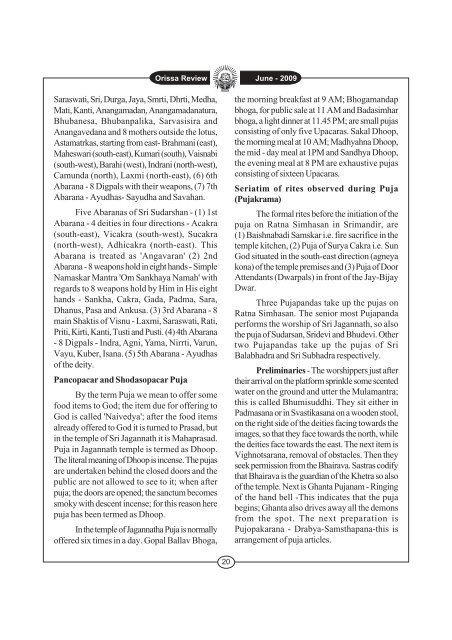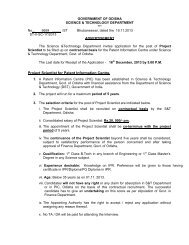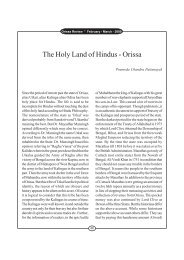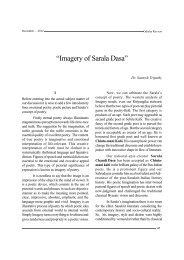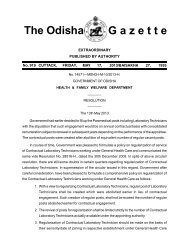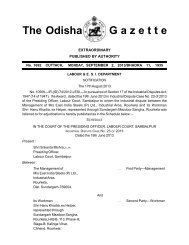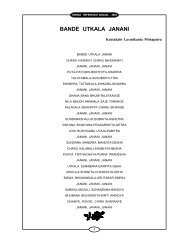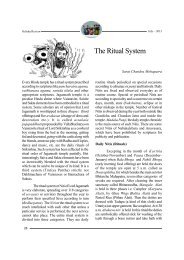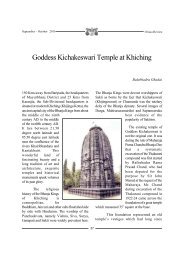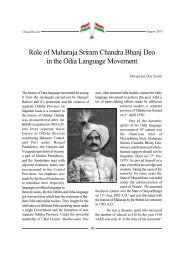Puja Rituals in Srimandir
Puja Rituals in Srimandir
Puja Rituals in Srimandir
You also want an ePaper? Increase the reach of your titles
YUMPU automatically turns print PDFs into web optimized ePapers that Google loves.
Saraswati, Sri, Durga, Jaya, Smrti, Dhrti, Medha,<br />
Mati, Kanti, Anangamadan, Anangamadanatura,<br />
Bhubanesa, Bhubanpalika, Sarvasisira and<br />
Anangavedana and 8 mothers outside the lotus,<br />
Astamatrkas, start<strong>in</strong>g from east- Brahmani (east),<br />
Maheswari (south-east), Kumari (south), Vaisnabi<br />
(south-west), Barahi (west), Indrani (north-west),<br />
Camunda (north), Laxmi (north-east), (6) 6th<br />
Abarana - 8 Digpals with their weapons, (7) 7th<br />
Abarana - Ayudhas- Sayudha and Savahan.<br />
Five Abaranas of Sri Sudarshan - (1) 1st<br />
Abarana - 4 deities <strong>in</strong> four directions - Acakra<br />
(south-east), Vicakra (south-west), Sucakra<br />
(north-west), Adhicakra (north-east). This<br />
Abarana is treated as 'Angavaran' (2) 2nd<br />
Abarana - 8 weapons hold <strong>in</strong> eight hands - Simple<br />
Namaskar Mantra 'Om Sankhaya Namah' with<br />
regards to 8 weapons hold by Him <strong>in</strong> His eight<br />
hands - Sankha, Cakra, Gada, Padma, Sara,<br />
Dhanus, Pasa and Ankusa. (3) 3rd Abarana - 8<br />
ma<strong>in</strong> Shaktis of Visnu - Laxmi, Saraswati, Rati,<br />
Priti, Kirti, Kanti, Tusti and Pusti. (4) 4th Abarana<br />
- 8 Digpals - Indra, Agni, Yama, Nirrti, Varun,<br />
Vayu, Kuber, Isana. (5) 5th Abarana - Ayudhas<br />
of the deity.<br />
Pancopacar and Shodasopacar <strong>Puja</strong><br />
By the term <strong>Puja</strong> we mean to offer some<br />
food items to God; the item due for offer<strong>in</strong>g to<br />
God is called 'Naivedya'; after the food items<br />
already offered to God it is turned to Prasad, but<br />
<strong>in</strong> the temple of Sri Jagannath it is Mahaprasad.<br />
<strong>Puja</strong> <strong>in</strong> Jagannath temple is termed as Dhoop.<br />
The literal mean<strong>in</strong>g of Dhoop is <strong>in</strong>cense. The pujas<br />
are undertaken beh<strong>in</strong>d the closed doors and the<br />
public are not allowed to see to it; when after<br />
puja; the doors are opened; the sanctum becomes<br />
smoky with descent <strong>in</strong>cense; for this reason here<br />
puja has been termed as Dhoop.<br />
In the temple of Jagannatha <strong>Puja</strong> is normally<br />
offered six times <strong>in</strong> a day. Gopal Ballav Bhoga,<br />
Orissa Review June - 2009<br />
20<br />
the morn<strong>in</strong>g breakfast at 9 AM; Bhogamandap<br />
bhoga, for public sale at 11 AM and Badasimhar<br />
bhoga, a light d<strong>in</strong>ner at 11.45 PM; are small pujas<br />
consist<strong>in</strong>g of only five Upacaras. Sakal Dhoop,<br />
the morn<strong>in</strong>g meal at 10 AM; Madhyahna Dhoop,<br />
the mid - day meal at 1PM and Sandhya Dhoop,<br />
the even<strong>in</strong>g meal at 8 PM are exhaustive pujas<br />
consist<strong>in</strong>g of sixteen Upacaras.<br />
Seriatim of rites observed dur<strong>in</strong>g <strong>Puja</strong><br />
(<strong>Puja</strong>krama)<br />
The formal rites before the <strong>in</strong>itiation of the<br />
puja on Ratna Simhasan <strong>in</strong> <strong>Srimandir</strong>, are<br />
(1) Baishnabadi Samskar i.e. fire sacrifice <strong>in</strong> the<br />
temple kitchen, (2) <strong>Puja</strong> of Surya Cakra i.e. Sun<br />
God situated <strong>in</strong> the south-east direction (agneya<br />
kona) of the temple premises and (3) <strong>Puja</strong> of Door<br />
Attendants (Dwarpals) <strong>in</strong> front of the Jay-Bijay<br />
Dwar.<br />
Three <strong>Puja</strong>pandas take up the pujas on<br />
Ratna Simhasan. The senior most <strong>Puja</strong>panda<br />
performs the worship of Sri Jagannath, so also<br />
the puja of Sudarsan, Sridevi and Bhudevi. Other<br />
two <strong>Puja</strong>pandas take up the pujas of Sri<br />
Balabhadra and Sri Subhadra respectively.<br />
Prelim<strong>in</strong>aries - The worshippers just after<br />
their arrival on the platform spr<strong>in</strong>kle some scented<br />
water on the ground and utter the Mulamantra;<br />
this is called Bhumisuddhi. They sit either <strong>in</strong><br />
Padmasana or <strong>in</strong> Svastikasana on a wooden stool,<br />
on the right side of the deities fac<strong>in</strong>g towards the<br />
images, so that they face towards the north, while<br />
the deities face towards the east. The next item is<br />
Vighnotsarana, removal of obstacles. Then they<br />
seek permission from the Bhairava. Sastras codify<br />
that Bhairava is the guardian of the Khetra so also<br />
of the temple. Next is Ghanta <strong>Puja</strong>nam - R<strong>in</strong>g<strong>in</strong>g<br />
of the hand bell -This <strong>in</strong>dicates that the puja<br />
beg<strong>in</strong>s; Ghanta also drives away all the demons<br />
from the spot. The next preparation is<br />
Pujopakarana - Drabya-Samsthapana-this is<br />
arrangement of puja articles.


